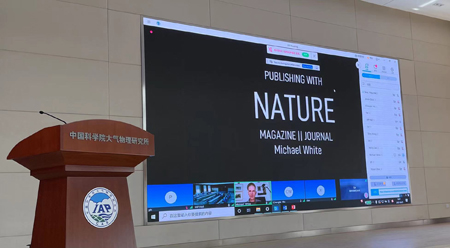Invited by Prof. CAO Junji, Director General of the Institute of Atmospheric Sciences, Dr. Michael White, the senior editor of Nature had a virtual visit to IAP via 2-day online meeting with the IAP researchers. Nearly a hundred researchers from the Institute participated in this online activity.
Michael WHITE delivered a talk on "Publishing with Nature", introducing the detailed process of publishing climate science research papers in Nature, together with some successful stories of Nature publications. Followed by Dr. White's talk, Prof. CAO Junji briefly introduced IAP and its recent research advances. 10 research division summarized their research updates, providing a comprehensive understanding about the research going on at IAP.
On the second day meeting, seven researchers from IAP gave presentations on the topics of "Realistic initial states of the Tibet Plateau contribute to high decadal prediction skills of global climate", "Future changes of monsoons", "Variations of the East Asian monsoon evolution and possible mechanisms", "Human contribution to climate change", "Stratospheric Harbinger of the North American Cold Events", "The land surface model CAS-LSM and its applications", and "Change of ocean heat content and transport under global warming". Dr. Michael WHITE commented on related works from the perspective of Nature.
In the summary part of the meeting, Dr. Michael White said, he is highly impressed by the achievements by IAP scientists and he is also interested in the study on the Chinese South-to North Water Diversion Project and development of CAS-ESM model.
The IAP researchers were shown the editorial managing process of the high profile journal and specific themes behind the climate science research published in Nature over the past 13 years. At the same time, they presented the research that IAP is currently undertaking and plans to develop in the future.
Michael White is Nature's editor for climate science, handling submissions on atmospheres, oceans, the cryosphere and hydrology – past, present and future, on Earth and other planets. Michael works closely with Nature’s editors for biogeoscience, economics, and ecology and is broadly experienced in interdisciplinary Earth System Science. Before coming to Nature in 2008, Michael was an academic at Utah State University, where he conducted research on land surface phenology and terrestrial biogeochemistry -- mostly using computational models and satellite remote sensing.


